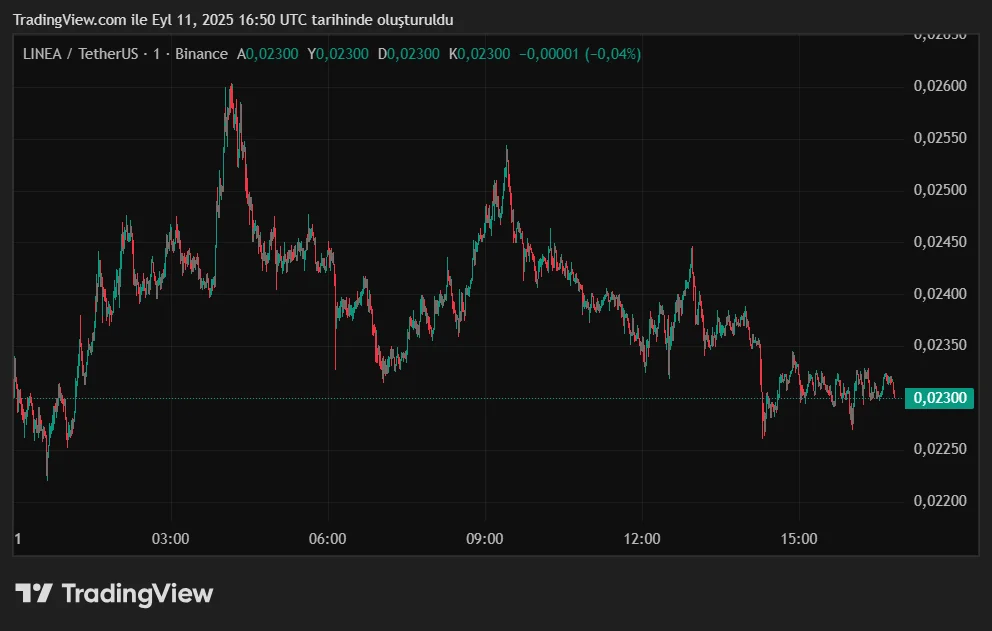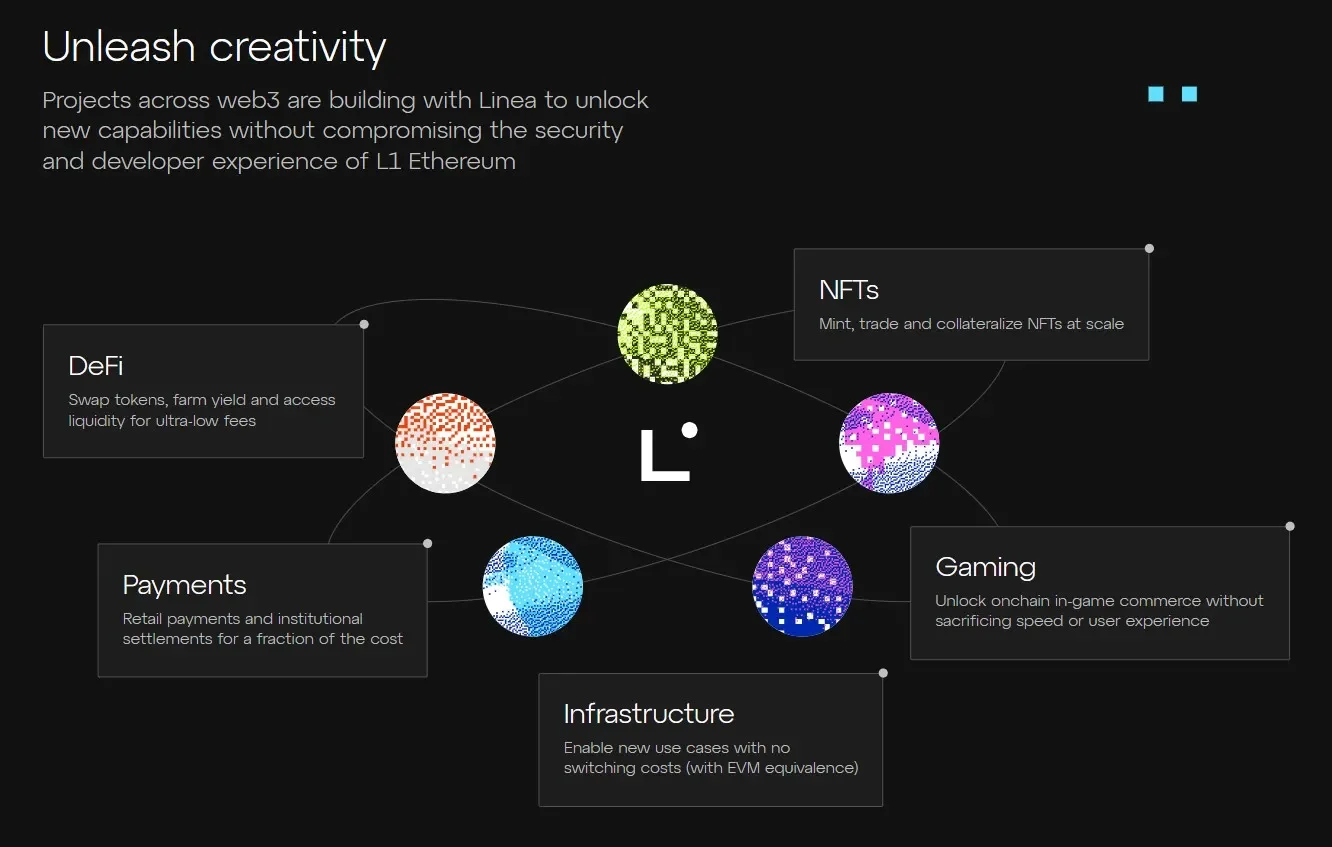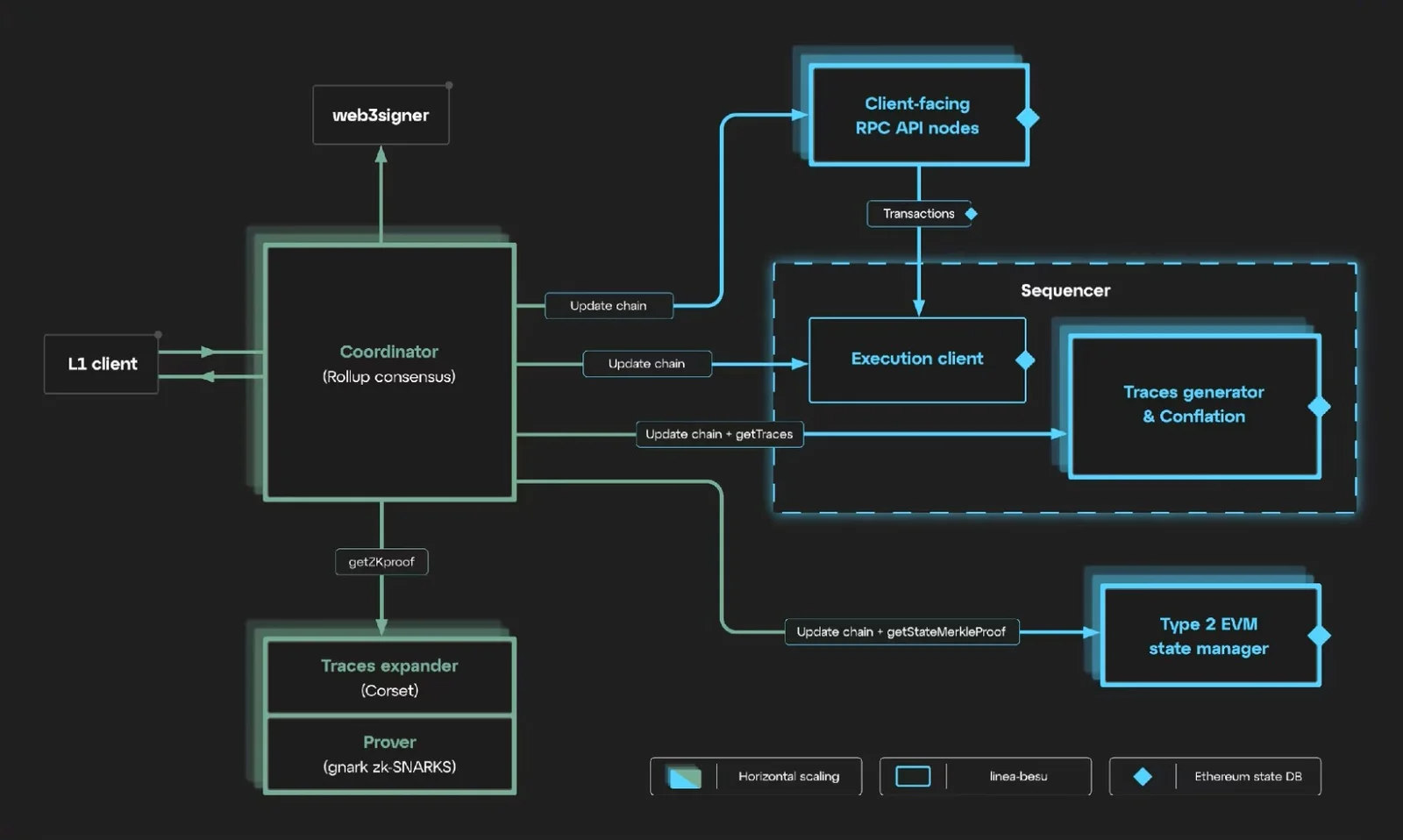Recently, an altcoin has been making headlines thanks to its listing on numerous exchanges and extensive airdrop process: Linea. Linea is a Layer-2 network designed to increase the scalability of the Ethereum blockchain. It uses zk-rollup (zero-knowledge-based) technology to process transactions in bulk outside the Ethereum main chain, prove their validity, and submit them to Ethereum. This allows for much faster and more cost-effective transfers compared to transactions on the Ethereum network. Because the Linea network was developed to be fully compatible with Ethereum (EVM-equivalent), smart contracts and applications on Ethereum can run on Linea without any modifications. ConsenSys, the developer of popular Ethereum tools such as MetaMask and Infura, is behind the project. Linea's native cryptocurrency, the LINEA token, was released to the community via an airdrop in 2025.
Linea (LINEA) Definition and Origins
Linea can be simply described as a scaling solution for the Ethereum ecosystem. It emerged as a Layer-2 network to address Ethereum's high transaction fees and limited transaction capacity. This network maintains Ethereum's security and decentralization while processing transactions on its own and sending them to the Ethereum mainnet with a hash proof. This reduces congestion on the Ethereum main chain and improves the user experience. Linea's technical foundation is zkEVM technology, powered by zero-knowledge proofs (zkSNARKs). This technology cryptographically proves to Ethereum that transactions are valid and allows them to be validated without revealing transaction details.
The emergence of the Linea project is part of a search for a solution to Ethereum's scaling problem. Initially known as ConsenSys zkEVM, the project was piloted by ConsenSys as a private testnet in late 2022. Then, in March 2023, ConsenSys launched a public testnet for its zkEVM solution and named the project "Linea." This test phase, announced with the "Linea" brand, generated significant interest in the Ethereum community. When announcing Linea, the ConsenSys team emphasized that it would integrate with the MetaMask wallet and Infura infrastructure, allowing developers to easily scale their applications without prior knowledge of the zk technology. The "Linea" in the project's name represents a line, a connection, between the Ethereum main chain and this second layer, representing a continuous data flow. ConsenSys, led by Ethereum co-founder Joseph Lubin, played a significant role in Linea's development, drawing on its experience and position within the ecosystem. Lubin founded ConsenSys in 2014 to support Ethereum's development and developed products like MetaMask, which have reached millions of users.

Linea (LINEA) History: Major Milestones
The Linea project has undergone several significant milestones throughout its development and launch. The key milestones in the history of the Linea network are listed below in chronological order:
• December 2022: ConsenSys launched a private testnet for its zkEVM solution, which will run on Ethereum. At this early stage, the project was known as "ConsenSys zkEVM," and initial trials were conducted as a closed beta.
• March 28, 2023: The public testnet was launched. ConsenSys released a public test version of its zkEVM-based Layer 2 network and officially renamed the project "Linea." With the announcement of Linea's public testnet, Layer 2 competition intensified, as rival projects Polygon zkEVM and zkSync Era also emerged around the same time.
• July 2023: Linea Mainnet Alpha launched. Following a roughly three-month testnet phase, ConsenSys announced the first mainnet version of the Linea network at the EthCC event in Paris in July 2023. Initially, only select partners were granted access, and the network was soon publicly available. With this mainnet alpha release, over 100 projects and 5.5 million unique wallets participated in the testing process on Linea, with a total of 47 million transactions reported.
• August 2023 - March 2024: Linea Voyage campaign. To incentivize user participation during the testnet and mainnet alpha phases, the Linea team launched an experience points (LXP) program called "Voyage." Users earned points for their transactions on the testnet and in applications, earning them the opportunity to earn future rewards. During this period, the Linea ecosystem grew rapidly, and many DeFi protocols and NFT projects integrated into the Linea network.
• May 2024: The Linea Surge liquidity program was announced. After the first months of the mainnet, a liquidity mining and incentive campaign called "The Surge" was launched to revitalize the DeFi ecosystem on the network. Under this program, users earned points called LXP-L by transferring assets to the Linea network and providing liquidity to the protocols. The launch of the Surge program saw a significant increase in the total value locked (TVL) and number of active users on Linea.
- November 2024: The end of the Surge program and the establishment of the Linea Association. The liquidity incentive program ended as planned in November. Although TVL and active user metrics decreased with the program's end, the Linea team took steps to prepare the network for more sustainable growth. Around the same time, ConsenSys announced the Switzerland-based Linea Association to ensure decentralized governance of the Linea network. This non-profit organization was created to oversee the network's development and future token distribution. The Linea Association was seen as a key step in the network's roadmap to full decentralization. • September 3, 2025: Airdrop eligibility announcement. The Linea team released a tool to check eligible addresses for the long-awaited LINEA token airdrop. With this tool, called the "Airdrop Eligibility Checker," users were able to determine whether they were eligible to claim tokens based on their past participation in the Linea Voyage and Surge campaigns.
• September 10, 2025: LINEA Token Generation Event (TGE) and airdrop commenced. LINEA coin, the native token of the Linea network, officially entered circulation with the TGE held on September 10. 10% of the total maximum supply of 72 billion LINEA tokens (approximately 7.2 billion) began being distributed to early adopters and contributors via airdrop. As part of the airdrop, users who collected at least 2,000 points in the Linea Voyage campaign and 15,000 points in the Surge campaign were eligible to receive rewards. Approximately 750,000 addresses were identified as eligible to receive a share of this distribution. The airdrop claim period is set to run for 90 days, after which time any unclaimed tokens will be transferred back to the Linea ecosystem fund. Linea's initial price was:

- September 2025: Exchange listing and liquidity programs. With the launch of the LINEA token, major cryptocurrency exchanges began listing the token. On September 8, 2025, Binance announced LINEA as the 37th project of its "HODLer Airdrop" program, distributing LINEA tokens to users who staked BNB on specific dates. Binance then opened trading pairs for LINEA, including LINEA/USDT, LINEA/TRY, and LINEA/BNB. OKX launched LINEA's listing on September 10 and initially implemented measures such as a $10,000 purchase limit per user to limit volatility. Additionally, the Linea network allocated 1.6 billion tokens to liquidity mining through its "Linea Ignition" incentive program to increase liquidity on DeFi platforms.
Why is Linea (LINEA) Valuable?
Why is the Linea network important and valuable? To understand this, it's important to consider both the project's technical advantages and its contributions to the ecosystem:
Fully compatible with Ethereum and easy to transition
One of Linea's biggest advantages is its full compatibility with the EVM (Earth-to-Earth VM). This allows existing smart contracts and decentralized applications running on Ethereum to be easily deployed to the Linea network with virtually no code changes. For developers, this means they can scale their applications on Ethereum without needing to learn a new language or rewrite their projects. As a result, the Linea ecosystem has quickly reached hundreds of integrations, including DeFi, NFT, gaming, and infrastructure projects. The fact that the MetaMask wallet and Infura infrastructure natively support Linea also streamlines the user and developer experience.
High scalability and low fees
With its zk-rollup technology, Linea can process significantly more transactions per second than Ethereum. This significantly increases the network's throughput and shortens confirmation times for users, even during peak periods. Moreover, because transactions are transmitted in bulk to Ethereum and data is compressed, transaction fees ("gas" fees) are designed to be 15-20 times cheaper than on the Ethereum mainnet. These lower fees are particularly advantageous in use cases like DeFi, which require frequent transactions. Linea aims to further increase transaction throughput on its 2025 roadmap, reaching thousands of transactions per second (approximately 5,000 TPS).

Strong security objectives
As a Layer-2 solution, Linea's value lies in its inheritance of Ethereum's security model. The validity of transactions on Linea is proven on the Ethereum main chain using zero-knowledge proofs (zk-SNARKs). This cryptographically guarantees that off-chain computations are performed correctly, eliminating the need to run each transaction on Ethereum. When the Ethereum network verifies these proofs of validity from Linea, transactions on Linea achieve finality. Furthermore, this model eliminates the 7-day waiting period seen with optimistic rollups, allowing users to withdraw instantly and quickly transfer their assets back to the main network. In short, because the Linea network borrows Ethereum's security, the security of user funds is maintained according to Ethereum standards.
Offers a fair and Ethereum-friendly token economy
The LINEA token, the native asset of the Linea network, has a different economic model than most competing Layer-2 projects. Firstly, unlike many networks, transaction fees on Linea are paid directly in ETH, not LINEA. This approach enhances financial compatibility with the Ethereum ecosystem and ties Ethereum's value to Linea activities. The LINEA token is not used for network governance and has no initial pre-distribution allocated to any specific investors or teams. Instead, 85% of the total supply is allocated for community and ecosystem development. 10% of this distribution will be immediately distributed to early adopters and contributors via airdrop, while the remaining portion will be distributed in a controlled manner by the Linea Consortium for long-term incentives, public benefit funds, and R&D. Not allocating any funds to investors or private sales makes Linea a more community-focused project.
Furthermore, Linea's economic model includes a burn mechanism for revenue generated from network activities in both ETH and LINEA. For example, 20% of net transaction fees collected on Linea are allocated to burn ETH, and 80% are allocated to buy back and burn LINEA tokens from the market. This double-burn mechanism rewards increased network usage with a decrease in the supply of both Ethereum and the LINEA token, thus contributing to Ethereum's value and making the LINEA token a deflationary asset.
ConsenSys Support
The presence of a well-established organization like ConsenSys behind the Linea project provides significant technical and financial support. To date, ConsenSys has raised a total of $725 million from investors such as Microsoft, SoftBank, and Coinbase Ventures, providing indirect assurance for Linea's long-term development. Furthermore, ConsenSys's extensive user base in the Ethereum world (such as MetaMask's millions of users) has accelerated Linea's rapid adoption. Since its mainnet launch, the Linea ecosystem has been enriched by the participation of major protocols: Numerous projects are active on Linea, including decentralized exchanges Aave and PancakeSwap; NFT projects; bridge protocol Stargate; and derivatives platform Satori.
The Future of Linea
The future of the Linea project offers both significant opportunities and points to be closely monitored. Looking at the roadmap, the Linea team has set ambitious goals for further network development between 2025 and 2026. One of the most important technical goals is to reach the Type-1 zkEVM level by early 2026. Type-1 zkEVM represents a second layer almost entirely equivalent to the Ethereum protocol, and achieving this level would mean Linea would have the same security and verification rules as Ethereum. There is also a plan to increase transaction processing capacity to a level where it can easily process thousands of transactions per second (0.5 gGas/sec, approximately 5,000 TPS) by mid-2026. If these performance targets are achieved, the user experience on the Linea network could become as fast and seamless as a centralized server.
Who is the Founder of Linea (LINEA)?
The founder and developer of the Linea project is ConsenSys, a leading blockchain software company in the Ethereum world. ConsenSys was founded in 2014 by Joseph Lubin, one of the co-founders of Ethereum. Therefore, it's safe to say that Joseph Lubin is the visionary behind Linea. Lubin contributed to Ethereum's early development and later developed critical infrastructure tools like the MetaMask wallet and Infura within ConsenSys. Linea was also implemented by this experienced ConsenSys team, and the project idea is based on the vision of pioneers in the Ethereum ecosystem like Lubin.
To ensure the project doesn't remain entirely centralized, ConsenSys established a Swiss foundation called the Linea Association at the end of 2024. In other words, Linea's management and development follows a model that began under ConsenSys' leadership but aims to evolve into an independent community structure over time. The project's core team includes experienced product managers like Declan Fox and engineers from the Ethereum community.
Linea's Technical Overview
Linea uses a zk-rollup approach, packaging numerous transactions off-chain and sending them to Ethereum all at once with a single proof of validity (zkSNARK). This allows for high scalability and low fees without compromising security. Unlike optimistic rollups, it operates on a "prove first, write later" principle, offering a near-instant finality experience; transactions are confirmed on Linea within seconds and become permanent on Ethereum shortly thereafter. In short, the core of Linea's "features" lies in ZK technology's excellent balance of speed and security.

Because the network is designed to be EVM-equivalent, smart contracts on Ethereum also run on the Linea network virtually without any changes. Developers don't have to rewrite existing Solidity code, and the user experience flows naturally with wallets like MetaMask. This compatibility is one of the most critical advantages accelerating adoption for Linea on Ethereum Layer 2.
In the architecture, a sequencer collects transactions and organizes them into blocks, while a prover generates a single, small zk-proof from the execution traces of these blocks. When the proof is sent to Ethereum, the blocks become hard final. The bridge component securely manages asset and message transfers from Ethereum to Linea. The plan is to make these critical components and operations more decentralized over time.
Linea's custom prover infrastructure focuses on rapidly generating zkSNARK proofs and is designed to scale to high transaction volumes. The goal is to both improve performance and strengthen resilience to future cryptographic threats. This ensures that technical capacity doesn't become congested as the Linea token and overall network economics grow.
The technical vision isn't limited to a single L2: The Linea Stack allows other teams to build their own Layer-2s using Linea technology. This allows for an interoperable, mutually reinforcing Linea ecosystem and "network of rollups." This structure paves the way for future revenue to be based not only on the operations of a single network but also on the expansion of the infrastructure provider's role.
On the security front, the codebase's progressive open-source approach, audits, and multi-client plans are prominent. The goal is to increase transparency, enable the community to identify potential vulnerabilities more quickly, and reduce dependency on a single client. In short: The short technical answer to the question of what Linea is is: it's a fast and low-cost second layer based on EVM-equivalent, zk-rollups, inheriting Ethereum security. This foundation also provides a clear answer to the question, "Will Linea coin/Linea token usage become congested if it increases?": The architecture is designed to increase performance as the scale grows.
Frequently Asked Questions (FAQ)
Below are some of the most frequently asked questions and answers about the new coin, Linea:
- What is Linea?: Linea is a Layer-2 network built on Ethereum. This ConsenSys-backed coin aims to maintain Ethereum's security while providing faster and cheaper transactions.
- Does Linea have a coin?: Yes, Linea has its own token. This token is used for transaction fees, staking, and various DeFi applications within the ecosystem.
- How does the Linea network work?: Linea uses zk-rollup technology to batch-transfer transactions to Ethereum. This increases scalability and reduces costs.
- Which exchanges is Linea listed on?: The Linea token is traded on most major cryptocurrency exchanges. Users can access it through spot, futures, and staking options.
- What does the future look like for Linea?: Thanks to its close integration with the Ethereum ecosystem, Linea is poised to host significant projects in the coming years. However, it's important to consider the risks before making an investment decision.